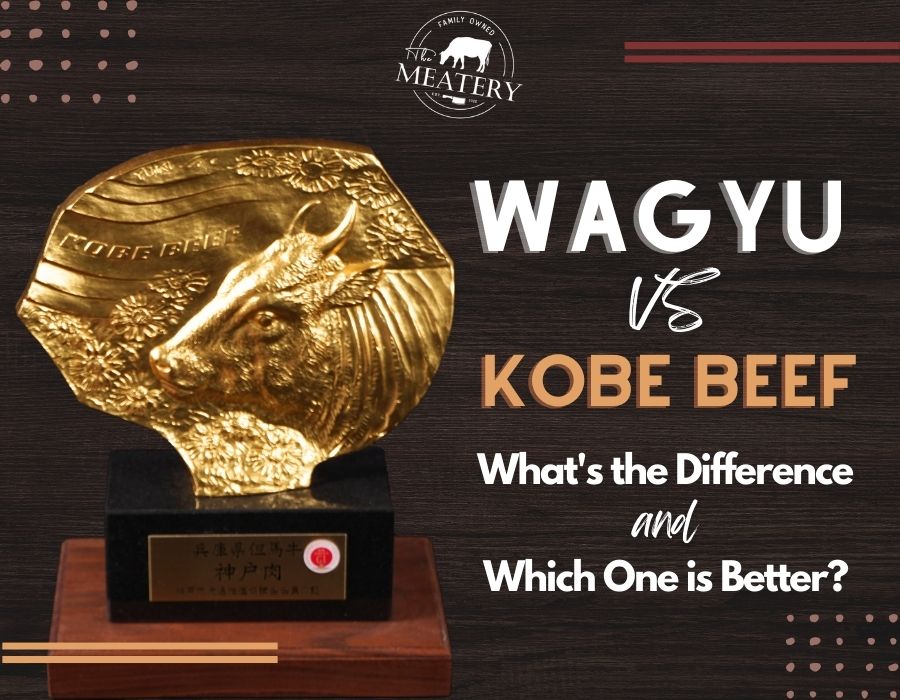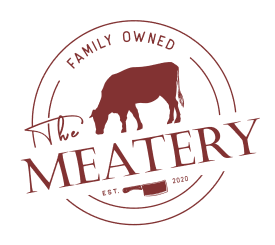When it comes to the world of luxury beef, two names often come to mind: Wagyu and Kobe. Both of these Japanese beef varieties have gained international recognition for their exceptional taste, marbling, and tenderness. But what sets them apart, and which one is truly the superior choice? In this article, we'll explore the differences between Wagyu and Kobe beef, and help you decide which one is right for you.
What is Wagyu?
Wagyu (和牛) translates to "Japanese cow" and refers to four specific breeds of Japanese cattle: Japanese Black, Japanese Brown, Japanese Shorthorn, and Japanese Polled. These breeds are genetically predisposed to producing a high degree of marbling in their meat. This contributes to the rich flavor and melt-in-your-mouth texture that Wagyu is known for.
Wagyu beef is graded based on its marbling, color, texture, and quality. In Japan, the highest grade is A5, which indicates exceptional marbling and quality. Wagyu is known for its intense marbling, buttery texture, and rich umami flavor. This is a result of the cattle's genetics, as well as the careful and specialized farming practices used in Japan.
What are the 4 types of Wagyu?
The four types of Wagyu refer to the specific breeds of Japanese cattle known for producing some of the highest-quality beef in the world. These breeds are:
-
Japanese Black (Kuroge Washu): The most common and highly prized breed, Japanese Black cattle are known for their exceptional marbling. Nearly 90% of all Wagyu beef comes from this breed, including the famous Kobe, Matsusaka, and Ohmi beef varieties.
-
Japanese Brown (Akage Washu): Also known as Kumamoto or Red Wagyu, this breed is leaner and has a slightly stronger flavor compared to Japanese Black. It’s known for its well-balanced fat content and rich taste, offering a lighter Wagyu experience.
-
Japanese Shorthorn (Nihon Tankaku Washu): This breed produces beef that is leaner with a robust, beefy flavor. Though less marbled than Japanese Black, Japanese Shorthorn is appreciated for its unique, savory taste.
-
Japanese Polled (Mukaku Washu): The rarest of the four breeds, Japanese Polled Wagyu offers a leaner cut with rich umami flavor. It is less marbled but highly sought after for its distinctive taste and texture.
Each of these Wagyu breeds has its own unique qualities, but they all share a commitment to the high standards that make Wagyu beef world-renowned.
Is ribeye The King of steaks?
Yes, the ribeye is often referred to as The King of Steaks due to its superior marbling, tenderness, and rich flavor. Cut from the rib section of the cow, the ribeye contains a high amount of intramuscular fat, which melts during cooking, giving the steak its juicy, buttery texture and exceptional taste. This high-fat content, combined with the meat's natural tenderness, makes the ribeye a favorite among steak enthusiasts.
The ribeye's balance of fat and flavor sets it apart from other cuts of beef, offering a more indulgent eating experience. Whether it's served bone-in or boneless, the ribeye delivers a full, beefy flavor that many consider the ultimate steak experience, earning its well-deserved title as "The King of Steaks."
What is Kobe Beef?
Kobe beef (神戸ビーフ) is a specific type of Wagyu beef that comes from the Tajima strain of Japanese Black cattle raised in the Hyogo Prefecture, with the city of Kobe being the capital. To be labeled as Kobe beef, the meat must meet strict criteria, including being born, raised, and processed in the Hyogo Prefecture.
Kobe beef is known for its exceptional marbling, tenderness, and flavor. It's considered one of the most exclusive and luxurious types of Wagyu beef available. In fact, only a small percentage of Wagyu cattle meet the criteria to be classified as Kobe beef.
Wagyu vs Kobe: A Comparison
While all Kobe beef is Wagyu, not all Wagyu beef is Kobe. This distinction is essential to understanding the differences between the two. Wagyu refers to the four specific breeds of Japanese cattle, while Kobe beef is a highly exclusive variety of Wagyu that comes from a specific location and meets strict criteria. Both Wagyu and Kobe beef are known for their exceptional marbling and flavor. But Kobe beef is generally considered to be of even higher quality due to its exclusivity and strict production standards.
A5 Wagyu is the highest grade of Wagyu beef, indicating exceptional marbling and quality. While A5 Wagyu is undoubtedly a premium beef, it's important to remember that not all A5 Wagyu is Kobe beef. Kobe beef, on the other hand, must not only meet the A5 grade requirements but also adhere to the strict criteria specific to the Hyogo Prefecture. Therefore, comparing A5 Wagyu and Kobe beef can be like comparing apples to oranges, as they are both high-quality but have different attributes.
Which is better Wagyu or Kobe?
Deciding whether Wagyu or Kobe beef is better depends on several factors, such as personal taste, budget, and availability. Both types of beef offer incredible taste but Kobe beef is often considered the more luxurious option due to its exclusivity.
Ultimately, the choice between Wagyu and Kobe beef comes down to individual preferences. Some people may prefer the rich, buttery flavor of a certain prefecture’s Wagyu, while others may be drawn to the exquisite marbling and slightly firmer texture of Kobe beef. The best way to decide which one is right for you is to try them both and compare their flavors and textures.
Is Kobe beef the same as Wagyu?
Kobe beef is a type of Wagyu beef, which means that it shares many similarities with other Wagyu varieties. Both Kobe and Wagyu beef are known for their exceptional marbling, flavor, and tenderness.
While Kobe beef is a type of Wagyu, it comes from a specific location and must meet strict criteria to be classified as Kobe beef. This exclusivity sets it apart from other Wagyu varieties and contributes to its reputation as one of the most luxurious types of beef in the world.
Can You Get Kobe Beef in the US?
Yes, you can get authentic Kobe beef in the United States, but it’s exceptionally rare. Kobe beef, which originates from the Tajima strain of Wagyu cattle in Japan’s Hyogo Prefecture, must meet strict criteria to be considered genuine. This exclusivity has made it one of the most coveted types of beef in the world, and its availability in the US is extremely limited.
The rarity of Kobe beef in the US is due to several factors:
-
Strict Japanese Regulations: Kobe beef is subject to stringent grading and certification by the Kobe Beef Marketing and Distribution Promotion Association in Japan. Only a small percentage of Tajima cattle meet the high standards required to be classified as Kobe beef. These include factors like marbling, quality of the meat, and the specific region where the cattle are raised.
-
Limited Exports: Japan only began exporting Kobe beef to the US in 2012, and even now, very little of it reaches American shores. This means that only a select number of restaurants and specialty markets in the US carry authentic Kobe beef. In fact, there are only a handful of certified Kobe beef distributors in the country.
Is Kobe more expensive than Wagyu?
In general, Kobe beef is more expensive than other types of Wagyu beef due to its exclusivity and strict production standards. However, the price of both Wagyu and Kobe beef can vary depending on factors such as grade, location, and availability.
The price of Wagyu and Kobe beef is influenced by factors such as demand, production costs, and availability. Kobe beef is typically more expensive because it's rarer and must meet strict criteria, while Wagyu beef may be more accessible and available in a wider range of grades.
Is Kobe Beef the Same as Wagyu?
Kobe beef is not the same as Wagyu, though the two are closely related. Wagyu refers to a group of Japanese cattle breeds known for their rich marbling, tenderness, and high-quality fat content. Kobe beef, on the other hand, is a specific type of Wagyu that comes from the Tajima strain of cattle raised in Japan's Hyogo Prefecture, under strict guidelines.
Only a small percentage of Wagyu cattle meet the rigorous standards required to be classified as Kobe beef, making it one of the most exclusive and sought-after types of beef in the world.
While all Kobe beef is Wagyu, not all Wagyu qualifies as Kobe. Wagyu can be raised in various regions in Japan or even in other countries like the US or Australia, but only beef from Tajima cattle, raised and processed in Hyogo Prefecture, can be called Kobe. This distinction, along with its meticulous grading process, is what sets Kobe beef apart from other types of Wagyu.
Is A5 Wagyu better than Kobe?
A5 Wagyu is the highest grade of Wagyu beef, with exceptional marbling and quality. It's a premium choice for those who appreciate the rich, buttery flavor and melt-in-your-mouth texture of Wagyu beef.
While A5 Wagyu is undoubtedly a high-quality beef, it's not the same as Kobe beef. Kobe beef must meet more criteria specific to the Hyogo Prefecture and is considered even more exclusive and luxurious. The choice between A5 Wagyu and Kobe beef will depend on individual preferences and budget.
Which prefecture has the best Wagyu?
When it comes to the best Wagyu, Japan's Hyogo Prefecture is often considered the top contender, as it is home to the world-famous Kobe beef. Hyogo's Tajima cattle, raised under strict conditions, produce some of the highest-quality Wagyu, known for its exceptional marbling, tenderness, and flavor.
Kobe beef from Hyogo is one of the most luxurious and sought-after varieties of Wagyu, earning global acclaim for its melt-in-your-mouth texture and rich, buttery taste.
However, other prefectures in Japan also produce outstanding Wagyu, each with its own unique characteristics. Mie Prefecture is renowned for Matsusaka beef, which rivals Kobe in quality, while Shiga Prefecture is famous for Ohmi beef, one of the oldest and most prestigious Wagyu brands.
Each region's climate, cattle breed, and farming practices contribute to subtle differences in flavor, but overall, Hyogo's Kobe beef remains the most iconic.
Where to Buy and How to Cook
When purchasing Wagyu or Kobe beef, it's essential to look for reputable suppliers that adhere to strict quality standards. It's also a good idea to familiarize yourself with the grading system to ensure you are getting the quality you desire. Many specialty butcher shops, high-end supermarkets, and online retailers offer Wagyu and Kobe beef. The Meatery, for instance, located in San Diego, CA is one of just a few online stores authorized by the Kobe Beef Association to sell genuine Kobe Beef.
Both Wagyu and Kobe beef require special care when cooking to preserve their unique qualities. Due to their high-fat content, these types of beef are best cooked using methods such as searing, grilling, or sous vide. Here are a few tips to help you get the most out of your Wagyu or Kobe beef:
-
Bring the meat to room temperature before cooking to ensure even cooking.
-
Use a hot pan or grill to sear the meat quickly, locking in the juices and flavors.
-
Cook the beef to medium rare to highlight its tenderness and marbling.
-
Let the meat rest for a few minutes before cutting to allow the juices to redistribute.
- Enjoy your Wagyu or Kobe beef with simple seasonings, such as salt and pepper, to let the natural flavors shine.
Wagyu and Kobe beef are both exceptional and luxurious types of beef. Each offers unique characteristics and flavors. While Kobe beef is a type of Wagyu, it's important to remember that not all Wagyu beef is Kobe. Ultimately, the choice between Wagyu and Kobe beef will depend on personal preference, budget, and availability. By understanding the differences and similarities between these two types of beef, you can make an informed decision and enjoy the unparalleled dining experience they provide.









